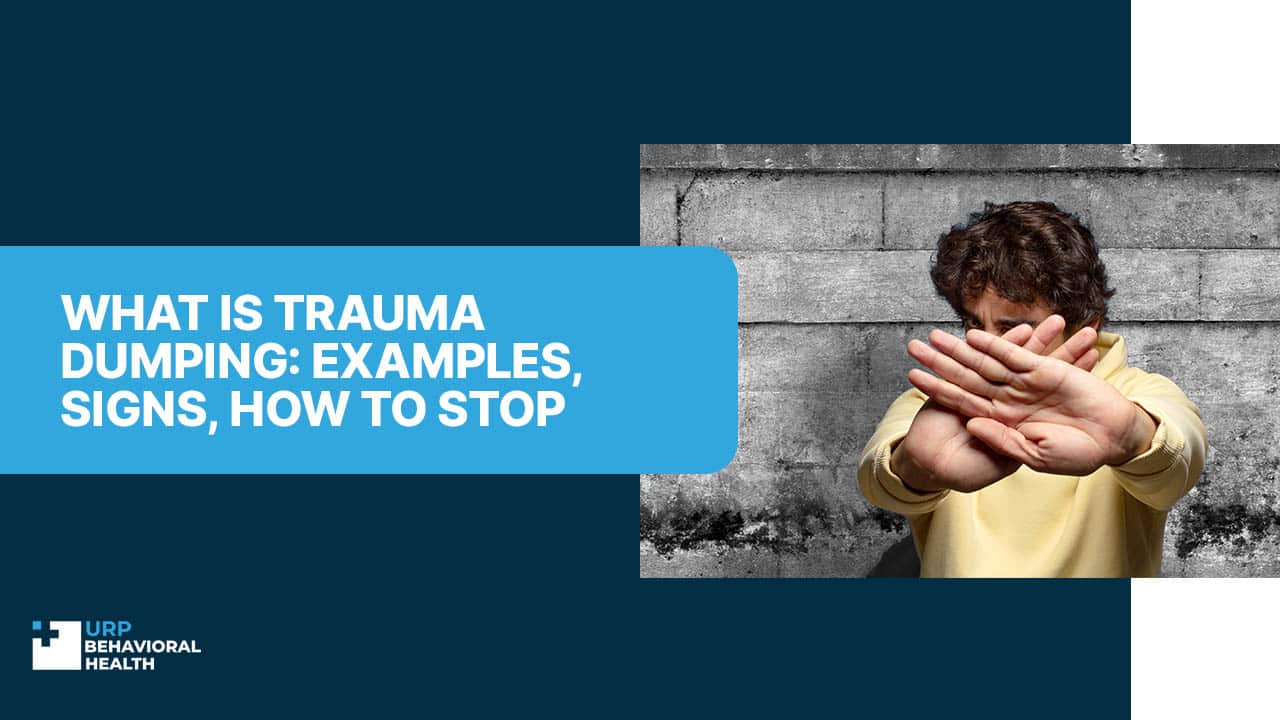
What Is Trauma Dumping: Examples, Signs, How To Stop
Facing traumatic events is painful. Often, people who experienced trauma recall the events that followed it again and again and thus, fall into trauma once again. Trauma treatment regularly includes sharing traumatic experiences, thoughts, memories, and feelings with other people. Therapists recommend their patients open up about their distressing events with their friends or family members to relieve pain and get support from them. Yet, is it always a good idea to place the burden of someone’s trauma on the shoulders of others? In some cases, venting (a term used for sharing your emotions with others) is a good thing as it can help reduce stress and find a solution while speaking about the problem torturing you. Yet, it is crucial to prevent venting from falling into trauma dumping. What is it, and how to recognize trauma dumping? These questions became the focus of our article.
What Is Trauma Dumping?
First, what is trauma dumping? It is not an official mental healthcare provider’s term but a colloquial phrase to highlight the toxic and unwished venting process. It is quite natural if you are frustrated with someone or something to talk about this to your friend or your partner. At last, when we speak our emotions loudly, we better cope with them and understand them. Yet, in some cases, when this venting process becomes persistent, obsessive, and works only one way, it becomes hard to experience for a person who receives all this information about traumatic events. That is, if you ask what does trauma dumping means, it is the process of oversharing negative emotions and thoughts related to traumatic experiences with others.
Our team will verify your insurance and design a plan tailored to your needs.
Which Factors May Boost Trauma Dumping?
Although over 3.9% of the global population has post-traumatic stress disorder [1], and this is the #1 factor for further trauma dumping, other mental health issues can also lead to such behavioral patterns. Typically, patients who practice oversharing of their trauma-related experiences suffer from the following mental state conditions:
- Depression and any depressive disorder;
- Anxiety;
- OCD which is trauma-boosted;
- Stressful environment at home or work.
At once, trauma dumping is not just talking about trauma anywhere and with anybody. It can be relieving for a person who experienced trauma but it can be harmful for their interlocutors. For example, there is evidence that trauma dumping can lead to retraumatization in people who have suffered from trauma and PTSD [2]. That’s why it is necessary to recognize trauma dumping and find a way how to stop it in a careful and non-traumatic way.
Examples of Trauma Dumping to Understand the Basics of This Condition
If you want to understand better what is trauma dumping, let’s compare some examples of such behavior with venting and find out the core differences.
Example 1
Constant posting of traumatic and emotional content on social media. People that overshare their trauma do not realize and they do not even think about how their content might affect others. For example, if a woman who lost her baby sticks to this topic and constantly posts on her Facebook account texts, images, and insights about her traumatic experience without any trigger warning, she may probably experience trauma dumping.
Example 2
Staying focused on a traumatic topic without understanding if it is appropriate. For example, an employee suffering from a difficult divorce shares his emotions with co-workers during working hours, distracting everyone from work and annoying them with their oversharing. It is normal to share your worries, bad thoughts, and memories with friends when they are ready to listen to you. If you share them with anyone around you in an inappropriate time or circumstances, you are trauma dumping. This refers not only to sharing your breakup with co-workers but also to other issues like oversharing trauma during a friendly party, a training session, or during their dating.
Example 3
Constantly use someone as a sounding board. Probably, the art of listening is the merit of one of your friends. Yet, if you are a downer constantly unloading such a listener with your traumatic experience, you are trauma dumping.
These are the simplest examples of oversharing you can detect in yourself or your friends. Consider them the most effective alerts about trauma dumping.
We’ll help you understand your options and guide you toward care.
Signs of Trauma Dumping to Check
Before we decide on how to recognize trauma dumping let’s learn why, at last, people act this way after they survived their traumatic event.
- The need for validation. This is just a shout for support and acknowledgement they release when they are passing hard times.
- No coping strategy. If a person doesn’t develop effective coping strategies to overcome trauma, they may turn to others to get relief.
- Lack of boundaries recognition. Often, trauma dumping occurs in persons who have problems with personal boundaries. They may think that everyone is ready to listen to them and provide support at any time and anywhere.
- Quick relief. Often, trauma dumping is a kind of strategy to get instant relief.
Yet, which are the core signs of trauma dumping and how can you differentiate it from a simple venting?
- Telling the same story once again. When you vent with a friend, you tell them about what’s frustrating you once, and then you forget about it or get an insight into how to solve the problem. In trauma dumping, people repeat their traumatic stories regularly.
- Frequent and inappropriate trauma breakouts. When you have a talk with a friend by phone in your free time and share your story, it is not oversharing. If you talk about it without permission from an interlocutor or talk about it when it is not appropriate, it is a sign of trauma dumping.
- Talking about trauma with strangers or people you barely know. It is essential to seek support from your close circle but it is oversharing if you talk about it with anyone who doesn’t belong to your close circle.
- No interest in others’ opinions. Trauma dumping doesn’t require any feedback from a listener. A person who overshares their trauma simply needs to talk about it without any constructive response.
- No need for the solution. Trauma is a problem and effective coping strategies are intended to solve this problem. Trauma dumping is not about a solution. It is only about unloading the burden of a traumatic experience on someone.
How to Stop Trauma Dumping? – 7 Ways to Avoid Oversharing
Trauma dumping can cause vicarious trauma in the recipient which results in anxiety, bad sleep, sadness, disturbances in eating habits, and fear. That’s why if you share your traumatic experience you should avoid becoming a dumper. You can do this in 7 ways.
- Practice mindfulness. You need to stay present and aware of your thoughts when you talk about hard things with anyone. Besides, mindful practices are great helpers for your coping strategies. Breathe deeply, make pauses when you talk about trauma, use grounding exercises, and constantly ask yourself if there is a right time and place to talk about your hurting topic.
- Always get consent before talking about trauma. When you need to share your traumatic experience you should understand whether a person you talk to is ready to listen to it.
- Decide on who is your close circle. It is about healthy boundaries as only your trusted friends or family members can provide you with relevant support.
- Think about what you want to get from venting. You should have a goal of why you are sharing your trauma-related experience. Is it support or endorsement? Or do you simply get better when speaking on the topic? Say about this goal before you start a talk.
- Free writing is sometimes better than venting. Develop the habit of writing down your thoughts and feelings and this can work similarly to talking to a friend. Yet, in this case, you do not overshare.
- The healthiest way to speak about your trauma is to speak about it to a professional. Today, mental healthcare offers various individual and group therapy methods based on talking and listening which can help overcome trauma.
- Be caring for yourself. You should understand that you do your best to cope with pain and even if you do not receive support, you are on the right way.
Trauma dumping is not a rare thing. It occurs even in the most mindful people as a result of deep pain and overwhelming, and it can be processed more healthily. Venting with a friend, practicing mindfulness, and getting professional mental healthcare support are essential when you struggle with traumatic thoughts, and these strategies also work great to avoid oversharing which can ruin your relationships and lead to isolation.
Don’t wait - confidential help is available right now for you or your loved one.
Resources:
- https://www.who.int/news-room/fact-sheets/detail/post-traumatic-stress-disorder
- https://www.newportinstitute.com/resources/co-occurring-disorders/trauma-dumping/#:~:text=Trauma%20dumping%20can%20trigger%20this,details%20of%20someone%20else’s%20experience.
















